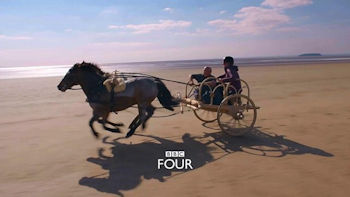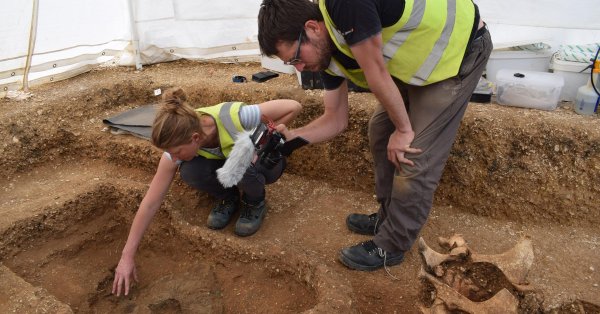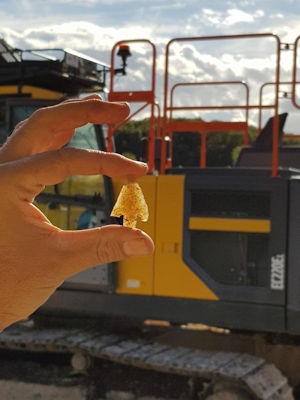|
Pocklington Heritage Partnership
Striving to showcase the rich history of Pocklington and district.
 The archaeological dig which preceded a housing development on Burnby Lane, Pocklington, in 2014 unexpectedly found part of an Iron Age cemetery, and the excavation was quickly listed as being of international importance. The archaeological dig which preceded a housing development on Burnby Lane, Pocklington, in 2014 unexpectedly found part of an Iron Age cemetery, and the excavation was quickly listed as being of international importance.
It produced around a thousand artefacts and some 175 burials from 87 square barrows. The grave goods include a sword, eight spears, several knives, the remains of a shield, pots, 600 glass and amber beads and bangles and over 20 brooches. In the closing weeks of the dig, in February 2017, a chariot was discovered – the first time an Iron Age chariot and charioteer buried with two horses attached has been uncovered in Britain for 200 years.
The excavation generated great interest within the local community; and the developers, David Wilson Homes, are keen to see the finds remain in the town. To try and bring this to fruition Pocklington Heritage Partnership (PHP) was formed consisting of representatives from local heritage groups, plus schools, town and county councils, archaeologists and interested and expert individuals.
Since PHP started its initiative in early 2017, further stunning ancient discoveries have been made locally. Pocklington is a popular place to live and it is currently growing through a number of new housing developments around the town; these sites have produced a host of finds and features to further enhance our knowledge of the rich historic landscape surrounding Pocklington and nearby villages.
Foremost in these more recent excavations was the discovery of an even more amazing chariot burial on the other side of Pocklington, on a Persimmon Homes development on The Mile. Less than 30 Iron Age chariots have been found in Britain, 90 % of them in East Yorkshire. The Mile burial is unique - chariot and horses interred upright and intact, with the middle-old aged charioteer laid on a bronze shield. Described as ‘Iron Age Britain’s most spectacular grave’, it was the focus of a BBC documentary in December 2018 that set out to show how civilized and skilled the Ancient Britons were in the Iron Age. The Mile chariot burial and the adjacent speared grave of a young warrior and young woman do not appear to be within an Iron Age cemetery, but the other side of the same field produced the remains of a rare mid-Saxon settlement site.
 In addition to the Burnby Lane chariot, which had survived for centuries under the roadside grass verge, the nearby burials included three men identified as warriors, a number of children - some of significant status with bangles and grave goods - and several female inhumations, one who died in childbirth. While the majority of artefacts span the Iron Age era; significant additional interest has been generated a small number of burials indicative of the early Anglian period. These contained grave goods identified as typical of the 5th to 7th century. In addition to the Burnby Lane chariot, which had survived for centuries under the roadside grass verge, the nearby burials included three men identified as warriors, a number of children - some of significant status with bangles and grave goods - and several female inhumations, one who died in childbirth. While the majority of artefacts span the Iron Age era; significant additional interest has been generated a small number of burials indicative of the early Anglian period. These contained grave goods identified as typical of the 5th to 7th century.
The range of burial types, including speared and crouched, and grave goods, some never previously known in the north of England, has resulted in extensive post-excavation investigation, including DNA and isotope analysis in Britain and the US. It is hoped this can shed more light on the link between the two periods, and whether the population was indigenous or immigrant. It will also hopefully produce more information on Pocklington’s progression from what is now confirmed as a significant Parisi centre into its next era as a Saxon town.
Burnby Lane is the biggest Iron Age cemetery to be discovered in the past 40 years; with techniques having developed so much in that period it allows for more detailed analysis than any previously undertaken, and is likely produce new revelations about Iron Age Yorkshire, augment our understanding and rewrite the history books. The analysis of The Mile finds will enhance this further.
 The Pocklington Heritage Partnership investigated how and where it might display the Burnby Lane artefacts locally. It subsequently extended its remit into producing a facility that could gather items and information from other eras and from the surrounding countryside and villages, enabling the full story to be told of the district’s rich history - one of continuous settlement going back 10,000 years, and packed with notable events and individuals and outstanding landscape. Furthermore, developing Pocklington’s long standing identity as ‘Gateway to the Wolds’, it could also become a hub for encouraging visitors to appreciate the unique prehistoric heritage of the Yorkshire Wolds. We have a model for town and countryside trails taking in nearby sites and earthworks, such as Grimthorpe hillfort and Huggate Dykes. The Pocklington Heritage Partnership investigated how and where it might display the Burnby Lane artefacts locally. It subsequently extended its remit into producing a facility that could gather items and information from other eras and from the surrounding countryside and villages, enabling the full story to be told of the district’s rich history - one of continuous settlement going back 10,000 years, and packed with notable events and individuals and outstanding landscape. Furthermore, developing Pocklington’s long standing identity as ‘Gateway to the Wolds’, it could also become a hub for encouraging visitors to appreciate the unique prehistoric heritage of the Yorkshire Wolds. We have a model for town and countryside trails taking in nearby sites and earthworks, such as Grimthorpe hillfort and Huggate Dykes.
PHP evaluated several possible venues, before linking with the Burnby Hall Gardens and Stewart Museum Trust in 2017. The Trust approached East Riding of Yorkshire Council about the possibility of taking back Burnby Hall itself, which had been separated from the gardens to become council offices in the 1960s, and discussions are ongoing.
Burnby Hall would make an ideal heritage, community and event facility, in addition to bringing house and gardens back together. PHP and the Gardens Trust, which has a long standing reputation as a well-run visitor attraction, joined forces to work together to develop a vision and plan to deliver a sustainable amenity for locals, visitors and schools. PHP and the Gardens Trust are approaching a number of local, regional and national parties to take this forward.
The project continues to be endorsed by the community, including generating over 5,000 signatures for a petition of support. Several locals have recently discussed donating notable artefacts or private collections to a heritage centre based in the town, covering Pocklington and surrounding villages, plus the Hayton roadside Roman settlement site.
Although the recent remarkable discoveries were unexpected by archaeologists and developers, perhaps it is not so surprising. Back in 1972 The Council for British Archaeology stated: ‘Pocklington has a great deal of potential in answering some of the questions about the emergence of towns in Britain’, an intriguing prediction, which now appears to be materialising some 50 years on.
Pocklington Heritage Partnership is under no illusion as to the size of the challenge it faces, both financially and meeting the demanding criteria for curating ancient artefacts. However, this is a once in a lifetime opportunity and there is a real determination to deliver a project which can be of such cultural, educational and economic benefit to the market town of Pocklington, its hinterland and the wider Wolds.
Phil Gilbank
Pocklington Heritage Partnership (December 2018)
|

